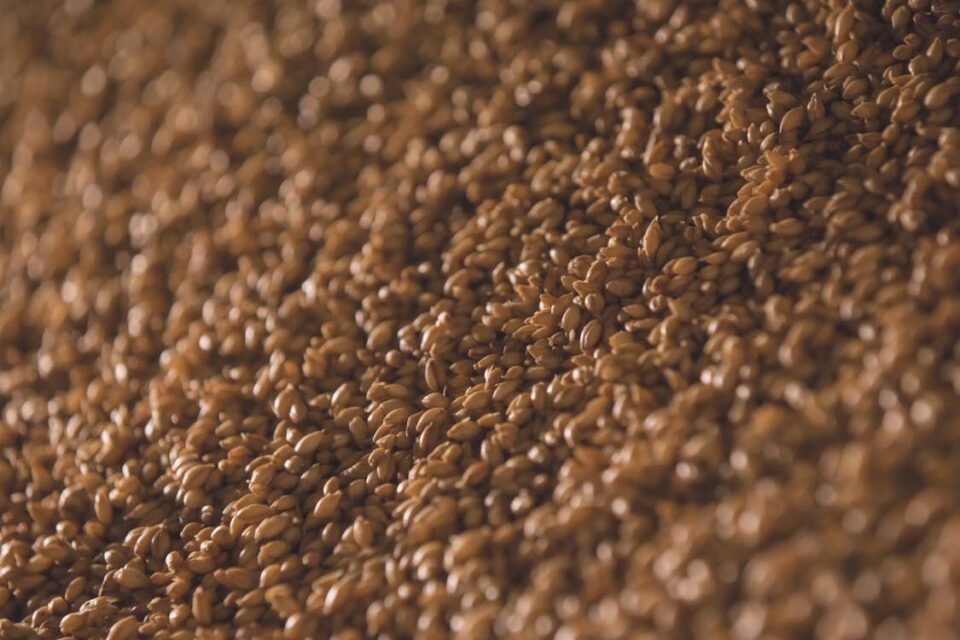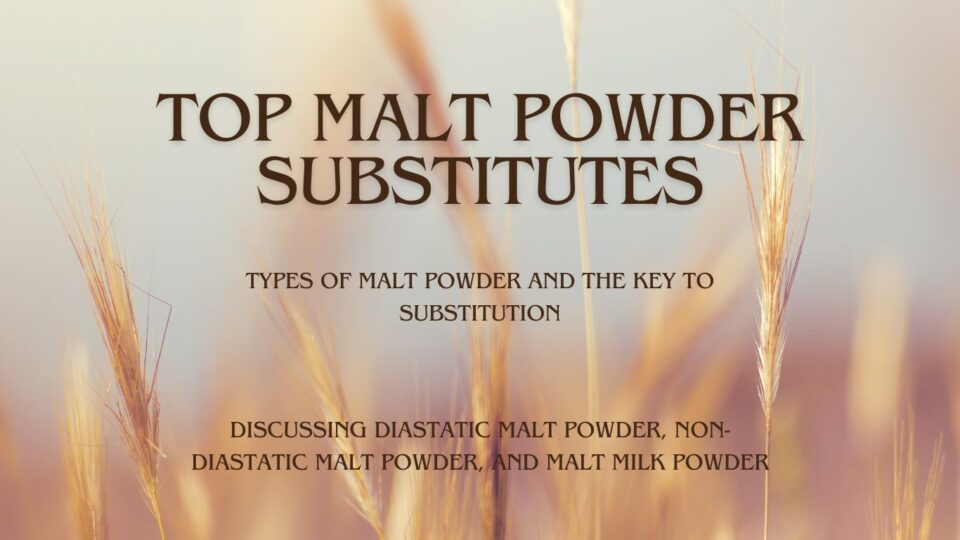Finding a malt powder substitute might sometimes be necessary, considering that this ingredient is often not readily available. But there’s another aspect that makes things more complicated – malt powder has three variations and they can all deliver different results. We’ll discuss these variants and substitutions in detail, but first, let’s get a quick answer for substitutions.
The best substitute for non-diastatic malt powder is maca root.
The top substitutes for malted milk powder are Ovaltine and coconut milk powder.
Other substitutes for diastatic and non-diastatic malt powder are malt syrup (barley or rice), soymilk powder, quinoa powder, and almond powder.
There is no exact substitute for diastatic malt powder, especially for baking. This is because the enzymes that play a key role in diastatic malt powder are often not available in other substitutes, which can be used in place of non-diastatic malt powder.
Now that we have the basics, let’s get into the nitty-gritty.
Table of Contents
Malt Powder Characteristics, Disambiguation, And Substitution Qualities
Understanding Malt Powder And Types
As we know, three types of malt powder that are generally available. These are:
- Diastatic malt powder
- Non-diastatic malt powder
- Malt Milk Powder
Now, let’s understand what malt is, and how these powders are derived.
Origins Of Malt And Its Processing Into Different Types
While many grains (including wheat) can be used, barley is the most popular grain for malting.
Malted grains find use in several cooking recipes, baking, and also syrups and beverages. If you’re fond of spirits, you may have noticed whisky and/or scotch talk of malt.
So, what is malt?
Essentially, malt is a whole grain that has started to germinate (i.e. sprouting a plant). Soon after it starts germinating, the process is stopped and the grain is dried using hot air. Because of this process, the taste of the grain changes, which is mostly attributed to enzymes (diastase enzymes) that are intended to help with the growth of the plant.
If the malted grain is powdered at this stage, it is known as diastatic malt.
If the malted grain is toasted to deactivate the enzymes and then powdered, it becomes non-diastatic malt powder.
Malt milk powder is a combination of non-diastatic malt powder, evaporated milk, and possibly sugar. This powder is somewhat popular commercially, and is often seen in flavored drinks. The exact combination and formula may vary by company. Some common examples of these commercial products include Ovaltine, Horlicks, and Milo.
Understanding Substitution Characteristics And Uses Of Malt Powders
Now that we know there are different types of malt powders, it stands to reason that they have different uses. Therefore, our substitutions must consider the type of malt powder and its characteristics.
Generally, the characteristics of diastatic and non-diastatic malt come into play during baking. Diastatic malt powder is often used with yeasted baked products. The enzymes in the diastatic malt powder become food for the yeast and help activate it. This often leads to better rise in the baked products, and a fluffier, loftier, and more tender food.
Both types of malt powder add a touch of sweetness and nutty flavor to the baked food. Additionally, the use of malt powder also helps with the browning of the crust as well as the sweetness. Non-diastase malt powder is a bit more effective in adding sweetness and a nuttier flavor, though diastase malt powder can be helpful with the texture of the baked product, while also adding some sweetness.

Top Substitutes For Malt Powder
1. Maca Powder
Generally speaking, maca powder is the best substitute for non-diastatic malt powder. It offers similar characteristics, including the sweetness and nutty flavor. It will also lend a bright golden color to baked goods, which while different from malt powder, is pretty good visually in its own right.
Since maca powder doesn’t have the same enzymes, it cannot be used as a substitute for diastatic malt powder in baked goods. Simply put, it will behave like non-diastatic malt powder and will not provide any extra fluffiness or texture to the baked product.
Maca powder is derived from maca root and is liked for its health benefits.
There is, however, the availability question to consider. Maca powder is not widely available and might be significantly difficult to acquire in several parts of the world.
So, while it’s technically the best substitute, it may not always be as easily available, and another option could be desirable.
2. Coconut Milk Powder
Coconut milk powder is an excellent substitute for malt milk powder. When used for a beverage (like milk), it offers the same consistency as malt milk powder would bring. Additionally, while there is a change in the overall taste and flavor, it isn’t radical.
It’s worth noting that coconut milk powder will bring a different color to the recipe and isn’t as sweet as malt milk powder.
Adding a bit of maple syrup should fix the sweetness and color brought by using coconut milk powder as a substitute. This substitution can work for non-diastatic malt powder as well.
If you don’t want to use maple syrup, it’s also okay to use honey for the sweetness and color.
3. Ovaltine (And Similar Nutrition Supplements)
Ovaltine is a popular nutrition supplement based on malt milk powder. It uses malt milk powder as a base and adds other ingredients to create a proprietary mix. This means it can be used as a substitute for malt milk powder in many recipes, though it might bring slight changes to flavors.
Of course, Ovaltine is just one of many nutrition supplements that use malt milk powder as the base. Depending on your location or preferences, you might also find products like Milo or Horlicks to use in place of Ovaltine.
4. Malt Syrup (Rice or Barley Malt Syrup)
You can get the simplest and most faithful substitution for malt powder by using malt syrup. Generally, the syrup is malt powder mixed with some water, and the solution is then reduced over heat to get a viscous and sweet malt liquid.
So, malt syrup works splendidly as an alternative to non-diastatic malt powder. When using this approach, remember that the syrup brings additional liquid and it might be necessary to account for this in the recipe.
Sometimes, people recommend the use of malt syrup as an alternative to diastatic malt powder. Some even suggest products like “diastatic malt syrup.” In my opinion, this doesn’t work as expected. The conventional malt syrup available in markets is non-diastatic.
And it makes sense, considering that making syrup involves heating the mix over a flame to reduce it. As we know, heat deactivates the enzymes, making the malt syrup non-diastatic. While some employ novel methods, the results are rarely satisfactory.
Bottom line: Malt syrup is a good substitute for non-diastatic malt powder. It doesn’t work as intended for diastatic malt powder.
5. Soymilk Powder
Soymilk powder is a surprisingly good substitute for malt milk powder. It works well for most beverages when used as a substitute. It might also be possible to use soymilk powder in some baking recipes to substitute non-diastatic malt powder, but its results may not be consistently good.
Another thing to remember here is that soy milk doesn’t have the same sweetness as malt milk powder. Adding some maple syrup or honey can help with the sweetness and the color of the recipe.
6. Quinoa Flour or Powder
Quinoa is quite a popular food these days, especially for its nutrition. If you’ve got some quinoa powder at home, it can work as a somewhat acceptable substitute for non-diastatic malt powder. It offers a similar touch of nuttiness, though it lacks the sweetness of malt.
7. Almond Flour or Powder
Almond powder can work as a substitute for malt powder in many recipes, especially baking recipes. It has a nutty taste and some sweetness. However, the flavor is notably different from malt and will make its presence felt.
It does help that almond flour works well for baking recipes, so while noticeable, the change can still be welcome if handled well.
Getting The Right Choice Of Malt Powder Substitutes
As we see in the discussion here, many foods can be an alternative to malt powder. However, given the variations in malt powder itself, you will have to be more circumspect about the substitute and its purpose.
It’s worth noting that diastatic malt powder doesn’t have a true substitute, though there are multiple options for non-diastatic malt powder and malt milk powder.

